Did you know that Alabama created the first state department of archives and history in the United States? It was founded in 1901 and “became a model for many other states.”1
Three cultural interests became the motivating interest to establish the department.
- Interest in improved education to foster a better informed and more civic-minded citizenry.
- Interest in preserving the material documenting the records and artifacts that tell the story of all people who have contributed to the building of the state.
- Interest in the creation of a state department to preserve the materials necessary for understanding our history.
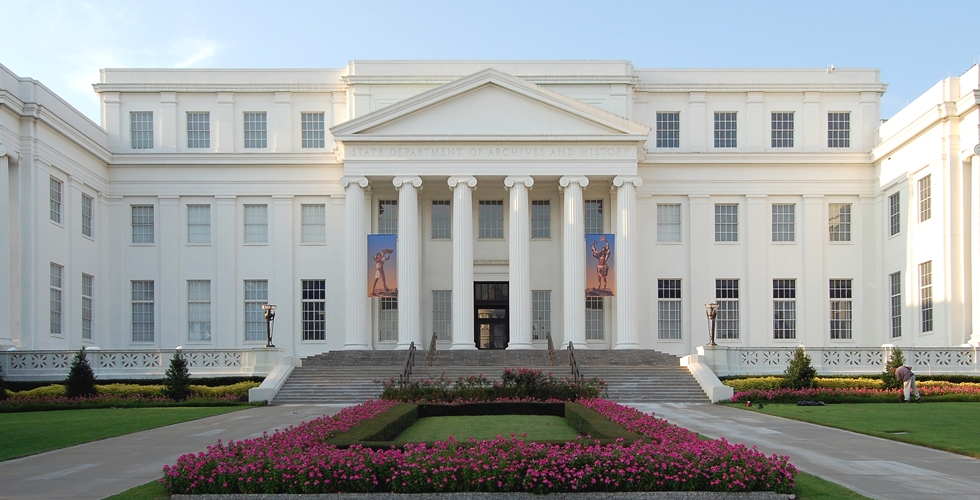
Original agency was the beginning of the public library movement in Alabama
Thomas McAdory Owen was the founder and first director of the Alabama Department of Archives and History. He served as director for almost 20 years “and built the Alabama Archives into one of the most important cultural agencies not only in Alabama but in the United States.
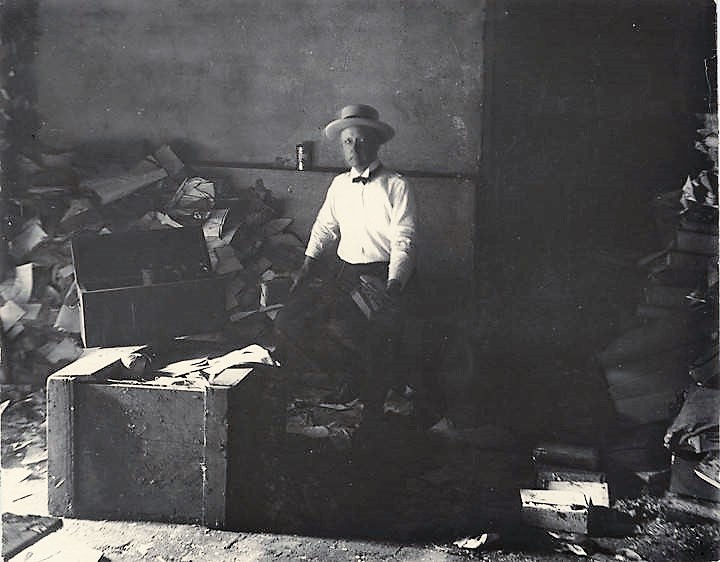 Thomas M. Owen sorting records in the basement of the Capitol in Montgomery, Alabama
Thomas M. Owen sorting records in the basement of the Capitol in Montgomery, Alabama
“In this original agency were the beginnings of the public library movement in Alabama, efforts to improve history education, a reference service for the legislature, research on and the marking of significant Alabama historical sites–all functions now performed by other agencies–along with other historical activities that continue to be carried out by the department.”2
The Archives was originally housed in the old Senate Cloak Room and was moved to the South Wing of the Capitol in 1906.
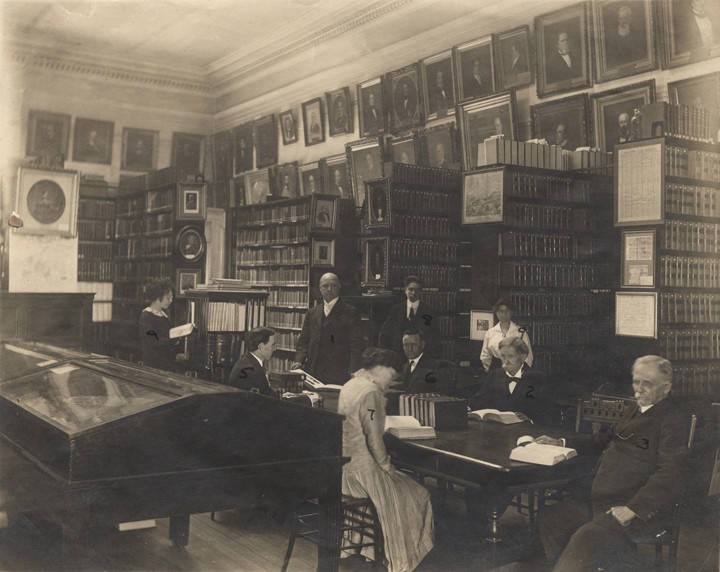 Staff of the Alabama Department of Archives and History in the archives room at the Capitol in Montgomery, Alabama ca. 1915 – The individuals in the photograph above are numbered and identified as follows: 1. Dr. Thomas M. Owen, Director; 2. H. S. Halbert, honorary curator; 3. J. W. Dubose, (historian) student; 4. Gertrude Ryan, librarian; 5. Peter A. Brannon, chief clerk; 6. Henry Knight, clerk; 7. Blendine Crowell, stenographer student” is crossed out and “stenographer” is penciled in beside]; 8. Carrol Smith, clerk; 9. Josie Shackleford, stenographer.” The Alabama Department of Archives and History was located in the Capitol until the World War Memorial Building was built in 1940. Before the construction of the Capitol’s south wing, the Archives used the House and Senate chambers when the Legislature was not in session.
Staff of the Alabama Department of Archives and History in the archives room at the Capitol in Montgomery, Alabama ca. 1915 – The individuals in the photograph above are numbered and identified as follows: 1. Dr. Thomas M. Owen, Director; 2. H. S. Halbert, honorary curator; 3. J. W. Dubose, (historian) student; 4. Gertrude Ryan, librarian; 5. Peter A. Brannon, chief clerk; 6. Henry Knight, clerk; 7. Blendine Crowell, stenographer student” is crossed out and “stenographer” is penciled in beside]; 8. Carrol Smith, clerk; 9. Josie Shackleford, stenographer.” The Alabama Department of Archives and History was located in the Capitol until the World War Memorial Building was built in 1940. Before the construction of the Capitol’s south wing, the Archives used the House and Senate chambers when the Legislature was not in session.
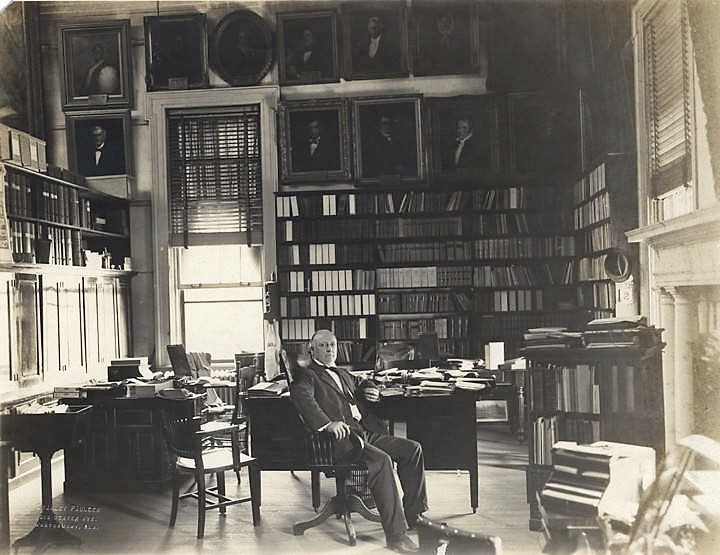 Thomas M. Owen at his desk in the Capitol in Montgomery, Alabama (Alabama Department of Archives and History)
Thomas M. Owen at his desk in the Capitol in Montgomery, Alabama (Alabama Department of Archives and History)
Widow secured funding
The Archives was originally housed in the old Senate Cloak Room and was moved to the South Wing of the Capitol in 1906.
Thomas Owen was succeeded by his widow, Marie Bankhead Owen.
“Although Thomas Owen’s initial fund-raising efforts (for a new building) were not successful, Mrs. Owen was later able to secure funding for a new building through the Works Progress Administration of the New Deal. Since her effort was a resurrection of her husband’s dream of a World War I memorial, the words “Alabama World War Memorial” are over the south entrance. At the time of its dedication in 1940, the new Alabama Archives building was one of the largest and most outstanding state history centers in the United States.”3
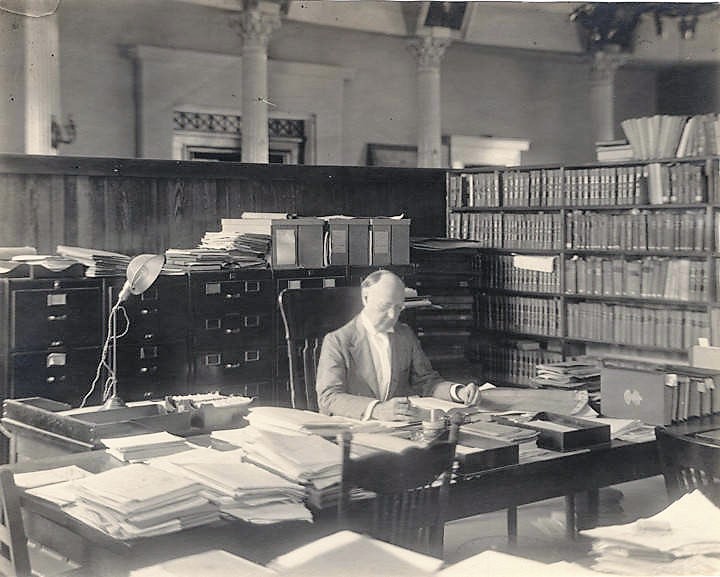 Thomas M. Owen at his desk in the Capitol in Montgomery, Alabama. (Alabama Department of Archives and History)
Thomas M. Owen at his desk in the Capitol in Montgomery, Alabama. (Alabama Department of Archives and History)
State funding has not kept up with needs
Despite its auspicious beginning as a model for other states, lack of adequate state funding over the years has not kept up with the needs of the department, and by the late 1970s, Alabama’s archives, museum, and records were far behind those of other southeastern states.
After 1980, attempts were made by the governor and the legislature to provide new funds and some programs were strengthened, but budget cuts in the 1990s, again resulted in program and staff reduction which continues today.
In 2019, Alabama will celebrate its Bicentennial and the Alabama Department of Archives and History is gearing up for the celebration. “To commemorate the state’s bicentennial, ADAH has digitized newspapers and records from Alabama’s territorial period (1817-1819) and the early days of statehood.” It is a wonderful way to see original documents pertaining to the beginning of our state.
1Alabama Department of Archives and History
2Alabama Department of Archives and History
3Alabama Department of Archives and History
ALABAMA FOOTPRINTS Confrontation:: Lost & Forgotten Stories
Prior to statehood, Alabama was a vast wilderness with a large Native American population. It is only natural that when new immigrants from other states arrived, conflicts over the land would arise. Soon, these small conflicts exploded into war.
Alabama Footprints Confrontation is a collection of lost and forgotten stories that reveals why and how the confrontation between the Native American population and settlers developed into the Creek-Indian War as well as stories of the bravery and heroism of participants from both sides.
Some stores include:
- Tecumseh Causes Earthquake
- Terrified Settlers Abandon Farms
- Survivor Stories From Fort Mims Massacre
- Hillabee Massacre
- Threat of Starvation Men Turn To Mutiny
- Red Eagle After The War


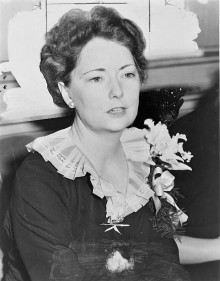
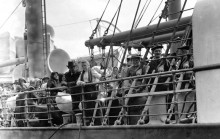
Wonderful place to visit
I knew this
Always loved going there but never knew this